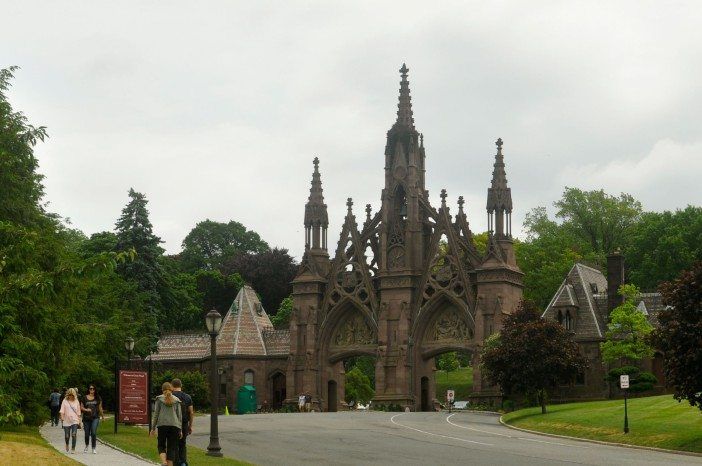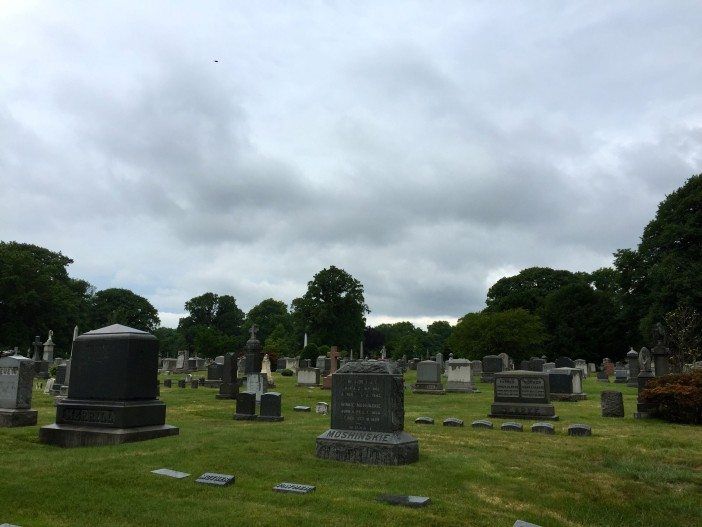Citing An Unusual Position, Green-Wood Cemetery Comes Out Against Full Landmarking

Green-Wood Cemetery has a strong track record of supporting historic preservation, but in an unusual move, the famous resting place of Leonard Bernstein and Jean-Michel Basquiat has come out against the recent push to preserve the entire cemetery through landmarking — with an important caveat, though.
The cemetery is one of nearly 100 sites that’s been at risk of being “de-calendared” by the Landmarks Preservation Commission (LPC), which will be dealing with that backlog of landmarking requests during a series of hearings beginning on October 8. But according to Green-Wood, they’re not completely interested in the coveted status.
“While we are flattered that the cemetery is being considered for landmark status, we oppose designating the entire cemetery — including grave sites — which would impose onerous, expensive, and impractical restrictions on our ability to function as an active cemetery,” Green-Wood president Richard J. Moylan said in a statement.
The strange position Green-Wood is in, as an active burial site, is essentially this: Imagine you own a plot at the cemetery, and you’d like a particular monument — does the cemetery then have to go through the LPC for each request? Would that increase wait-time for burials, and would it increase their cost?
“Designation of our burial areas would create significant practical difficulties for our continued operations and for the families of those who choose Green-Wood as their place of final repose,” Moylan added.
Green-Wood, which has long supported historic preservation — its Gothic Revival main gate was designated a city landmark in 1966, it’s currently working with LPC to restore and update the city-landmarked Weir Greenhouse, and the cemetery is designated as a National Historic Landmark — has, as it turns out, been against this wholesale landmarking for quite some time.
In 1981, when it was originally added to the LPC calendar, Julian D. Fairchild, Green-Wood’s president at the time, issued a statement to the LPC in which he stated that during its long history, the cemetery had “consistently demonstrated that it cares enough to preserve itself,” while worrying that the burden of landmarking could seriously damage its future.
From his letter to LPC:
As a public cemetery, Green-Wood is governed by the New York State Cemetery Law which has as one of its purposes the preservation and maintenance for all time of public cemeteries such as Green-Wood. The State’s preservation objectives are achieved by the requirement that Green-Wood fund and maintain trust funds, the income from which is required to be applied to the preservation and maintenance of grounds and facilities belonging to the cemetery corporation. If the Commission were to require that Green-Wood also assume the responsibility for the preservation and maintenance of structures on burial sites, the proceeds from these trust funds would be insufficient to meet the expanded preservation burden. Given the comprehensive in-place requirements of the Cemetery Law, I sincerely doubt that Green-Wood would be allowed to expend its funds in a manner not provided for by State law upon the preservation of structures which are not its property.

Though Green-Wood may not benefit from such wholesale landmarking as is currently being proposed, there are still structures at the cemetery that could use some individual attention from LPC, as Moylan points out.
“We are working with the staff of the LPC to identify which architecturally significant Green-Wood owned structures could be appropriately recognized consistent with our mission,” he said in the statement, which notes he will offer testimony at the LPC hearing on October 8.
When asked about the possibility of granting landmark status to individual structures rather than the whole cemetery, the LPC said that while it’s unable to comment in advance of the hearings, it “has designated lots in part in the past.”
Such buildings might include its 1911 chapel, which was designed by the architects behind Grand Central Terminal, and the gatehouse located at the Fort Hamilton Parkway entrance, which, following a recent renovation, gained the cemetery a preservation award from the New York Landmarks Conservancy.
“Green-Wood has done an exceptional job caring for its grounds and monuments,” says Peg Breen, president of the Landmarks Conservancy. “But I don’t think its necessary to landmark the entire site — I agree it presents difficulties. I think that Green-Wood has a reasonable case for why the entire site shouldn’t be landmarked, but I hope that [the LPC] would support those two other buildings.”
But that could require more time — just hopefully not another 34-year wait on the LPC calendar.




